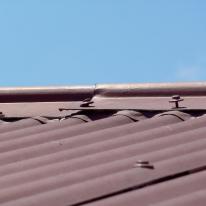Roof flashings lifting
Flashings play a key role in weathertightness. If they have lifted, there is a risk of water entering the building
Causes
Listed under: metal, Roof, flashings, wind, moisture, fixings and hardware, fixings, lead, leaks, weathertightness
Cause
Fixings have pulled out
Repair
- replace fixings that have pulled out with new screw-fixings
- if the flashing is intact, re-dress (shape) the soft edge to the roofing profile
- if the flashing requires replacing, use a heavier grade soft-edge flashing
- when working at height, always let someone know. Ensure the access ladder is in good condition and is securely set up on a solid level base. The correct angle for the ladder is 1 metre out from the wall for every 4 metres of height.
Cause
Insufficient number of fixings for the wind loads
Repair
- add screw or rivet fixings
- if the flashing is intact, re-dress (shape) the soft edge to the roofing profile
- if the flashing requires replacing, use a heavier grade soft-edge flashing
- when working at height, always let someone know. Ensure the access ladder is in good condition and is securely set up on a solid level base. The correct angle for the ladder is 1 metre out from the wall for every 4 metres of height.
Cause
Lead or soft edging has torn or lifted
Repair
- replace fixings that have pulled out with new screw-fixings
- if the flashing is intact, re-dress (shape) the soft edge to the roofing profile
- if the flashing requires replacing, use a heavier grade soft-edge flashing
- when working at height, always let someone know. Ensure the access ladder is in good condition and is securely set up on a solid level base. The correct angle for the ladder is 1 metre out from the wall for every 4 metres of height.






